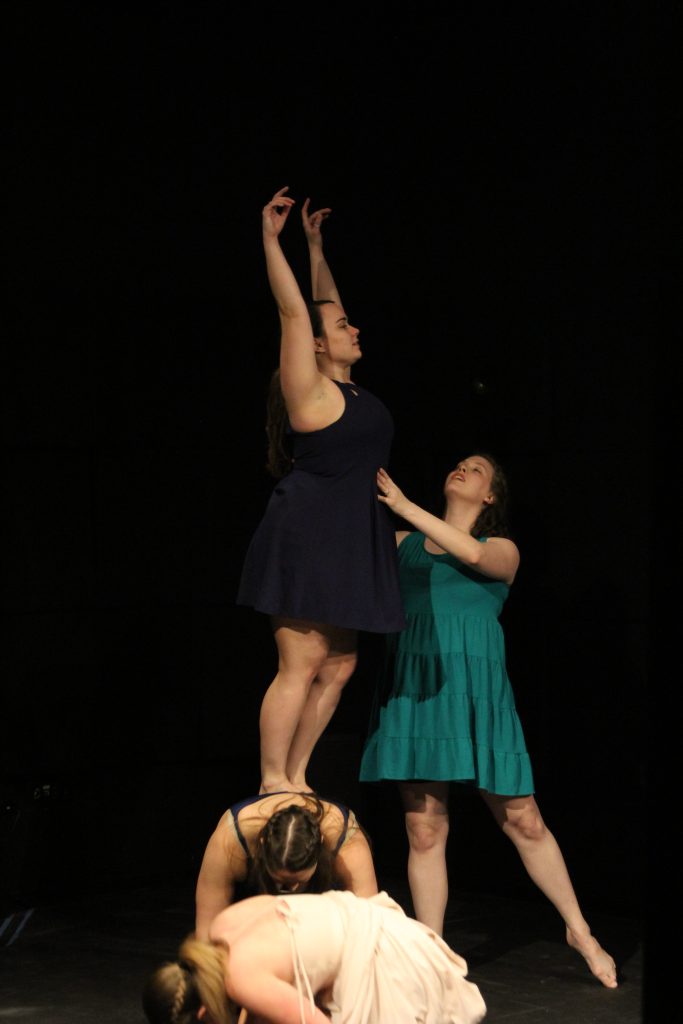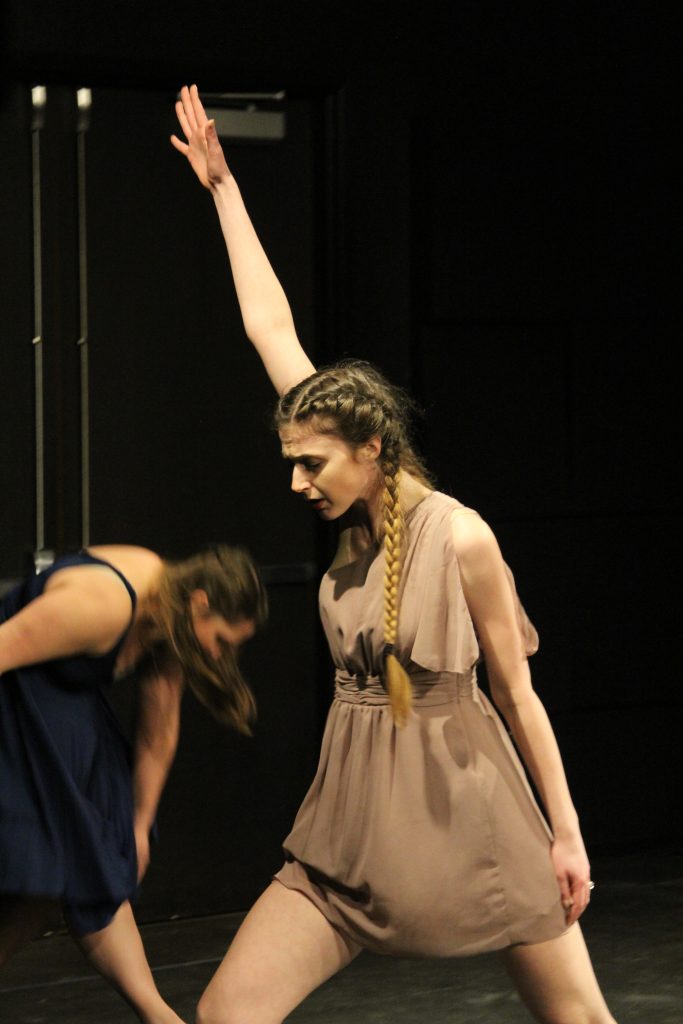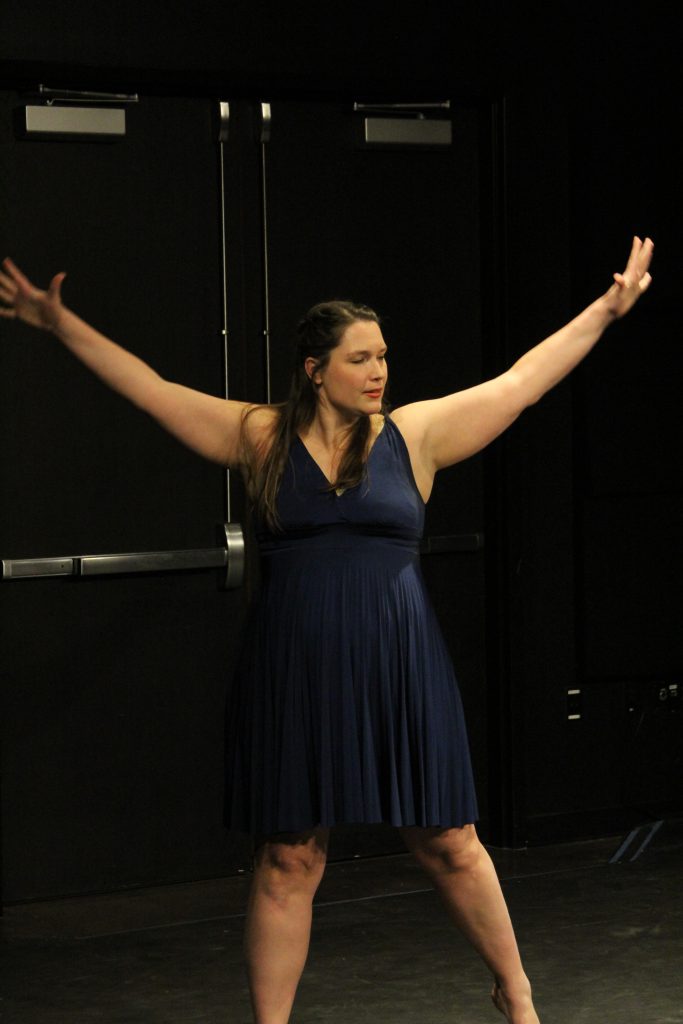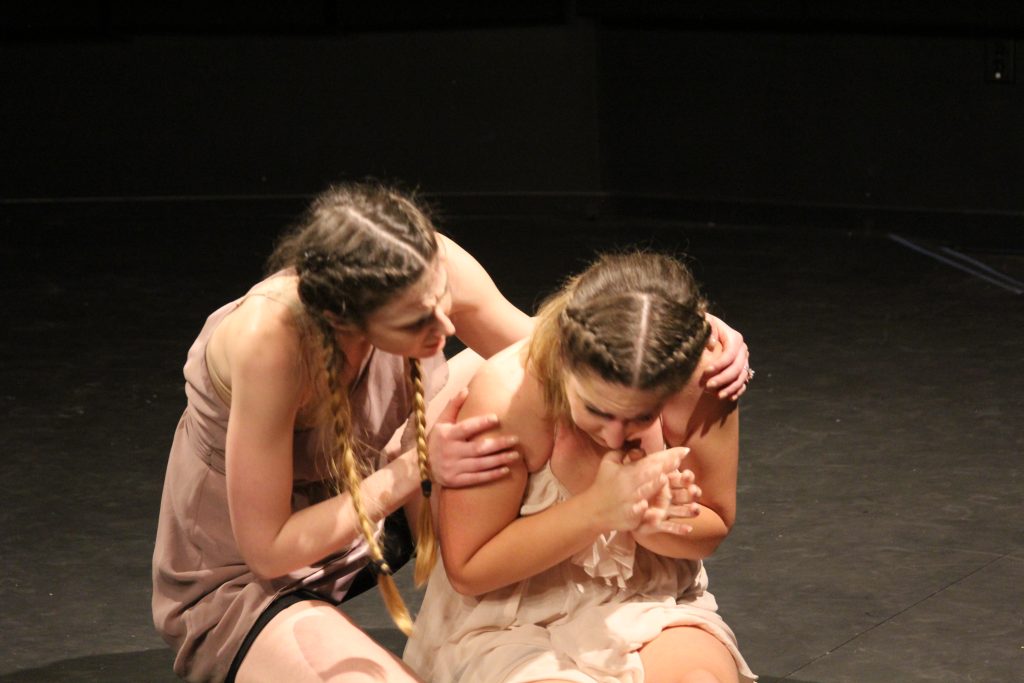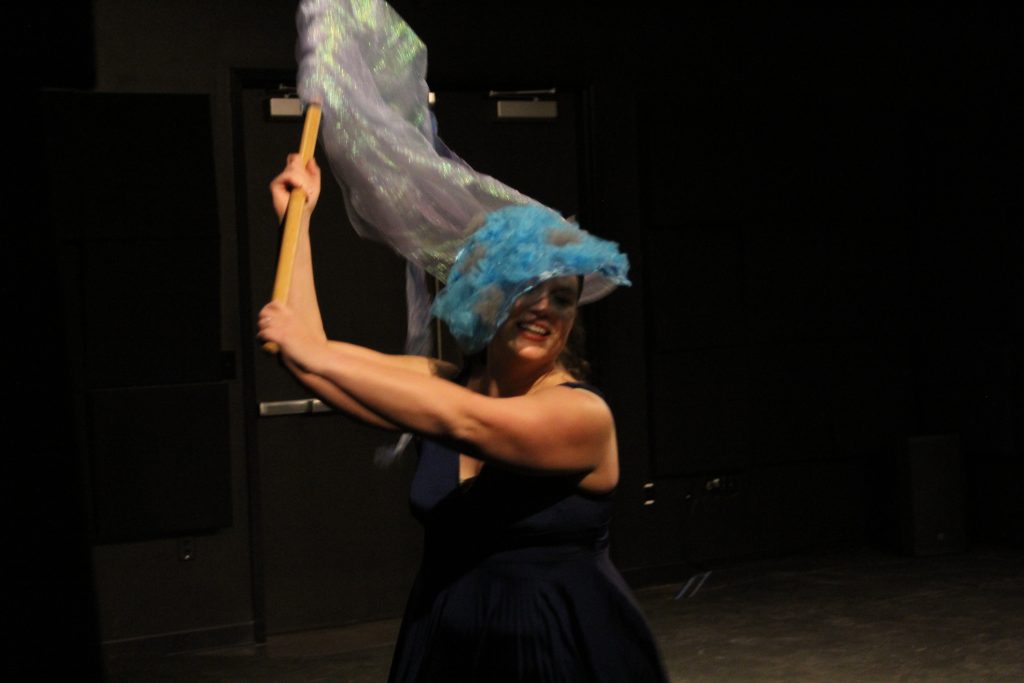Written by Maya Van Wagenen
It’s one of those unbearably beautiful days. The temperature is faultless—the low seventies of a mild Georgia spring. Bright pansies and ornamental kale spill from the tall planters lining the concrete deck of the Alpharetta Arts Center. The building itself has a midcentury ranch-style charm with a massive glass block wall and clean, geometric profile. At the far end of the patio, a man sits at an outdoor piano that’s been painted to look like stained glass.
The five members of Sideways Contemporary Dance Company stretch in the sunshine like cats on a wrap-around porch. This is only their second time seeing the venue, but that doesn’t seem to phase them. They warm up their muscles with foam rollers and massage guns, laughing at the irony of such perfect weather for an indoor performance.
Sideways has appeared in a variety of settings in its sixteen-year existence: rainy outdoor festivals, opulent hotel ballrooms, cramped Atlanta stages, a Catholic high school auditorium. Adaptability comes naturally to these long-time members of Sideways. In 2022, the company includes five dance educators from Macon to Cumming who believe in the artform’s unique ability to reach people. Unlike other performance companies, Sideways isn’t motivated by seeking out dance lovers. Instead, its mission is to create them.
Converting skeptics isn’t something that intimidates Charlotte Foster Williamson, the founder and director of Sideways. In fact, she relishes the opportunity to change minds and broaden perspectives. Her method doesn’t rely on impressing the audience with daring tricks, flawless technique, or pretentiously confusing motifs. Instead, she works to make contemporary dance accessible by being open with the audience about the choreography’s inspiration, message, and meaning. With this transparency, Sideways can inspire an emotional journey for the entire audience. This is the crux of Charlotte’s strategy. “You can’t unfeel something you’ve felt,” she reasons. This philosophy also guides how she chooses company members. They could be the most impressive technicians she’s seen, she explains, but Charlotte looks for dancers who can tell her a story. And make her believe it.
Mary McIntosh is a dance teacher at a public magnet school and the longest-participating member of Sideways. “Not every dance company would let me continue with them this long,” she explains during the Q and A session following the first show. This sentence seems ludicrous to non-dancers outside the superficial rules and traditions that often govern this world. Mary is an incredible performer and nuanced storyteller who moves with both beauty and power across the stage. But while other vocations often view age as an asset of gained experience and knowledge, the field of professional dance places a high value on youth. Attending other contemporary dance shows in Atlanta, one notices the emphasis on young, underfed bodies balanced on the knife’s edge between function and frailty. This dangerous ideal descends from the goal of traditional ballet: to present ballerinas as ethereal, otherworldly creatures that transcend the impediments of humanity.
Mary is not frail, nor are any of the other Sideways dancers. They couldn’t be frail and perform such athletic and emotional choreography. The title of this year’s show is Blackout. The performance strives to explore themes of systemic oppression through the framework of Isabel Wilkerson’s 2020 book Caste: The Origins of Our Discontents. Wilkerson generously gave permission for her words to appear in the printed program and serve as a script between dances. These readings are integral to Blackout’s mission and impact, adding history, context, and weight to the show.
Charlotte approaches Blackout with a small cast, testing each dancer’s range and flexibility. Most of the performers go back and forth between persecuted and persecutor—identities indicated by warm and cool colors respectively. These quick changes don’t just relate to costumes, but also require the dancers to immediately shift their interactions and intention. Personifying such a heavy power struggle requires that the performers rely on each other physically and emotionally. To portray distrust, the cast members express that they must be even more trusting of their fellow artists. This physical and emotional vulnerability is made more poignant by their chosen venue—the intimate Alpharetta Arts Center.
In this space, Sideways fully inhabits its mission of embracing humanity in dance. There is no gloss and blur of a far-off stage, where carefully orchestrated lighting washes the performers in dramatic colors. In fact, the only distinction between the “stage” and the audience is where the members of the Sideways board decide to set up the first row of folding chairs. Throughout the entirety of Blackout, viewers are close enough to see minute details of every dancer: beads of sweat, tattoos and scars, the glistening sheen of numbing ointment rubbed into aching muscles. The floor takes its toll over the four-show run, leaving the costumes frayed and the dancer’s backs, knees, hands, and feet flushed and scraped. By the final show, drops of blood shine black on the painted floor, tokens of the dancers’ dedication.
Even with Blackout’s moving score, it’s impossible to escape the sounds of dance—the low shuffling of every footfall, the swish of bodies against each other, the staggered intake of gasping breaths. Truthfully, breath might be one of the most intense parts of the performance. At the Q and A session after each show, several audience members comment on the profound feelings elicited by the noise of the five dancers breathing, although none of them can place why the experience is so powerful. Perhaps it’s a result of the years in pandemic and the critical distance we kept from one another for so long. Breath was dangerous then. Breath took the lives of one million of our countrymen.
In a post-vaccine world, it’s surprisingly touching to see each of the dancers inhale and exhale, to see breath as life-giving energy powering their every movement. It fuels them, as Sideways member Megan Long describes, to be a blank canvas. “We walk into the space ready to take on what the choreographer wants. Whatever story you have to tell yourself to get you there, you tell it.” This last statement is especially impactful with the knowledge that several of the dancers come to Blackout after loss, injury, or in the midst of major life transitions. Talented artists, the five find ways to channel their own experiences into their characters to create resonating feelings.
Megan Long, on her fourth season with Sideways, beautifully captures a heart wrenching, nuanced role. Dressed in warm colors, she goes through a process of subjugation, abuse, and disclosure. During a particularly painful part of the show, when Megan is tied up by her fellow dancers and thrown to the ground, the narration of Wilkerson’s book tells the story of Rubin Stacey.
“It is July 19, 1935. They are all standing at the base of a tree in the pine woods of Fort Lauderdale, FL. Above them hangs the limp body of Rubin Stacey, his overalls torn and bloodied, riddled with bullets, his hands cuffed in front of him, head snapped from the lynching rope, killed for frightening a white woman. The girl in front is looking up at the dead black man with wonderment rather than horror… The fascination on her young face set against the gruesome nature of the gathering was captured by a photographer and is among the most widely circulated of all lynching photographs of twentieth-century America.”
On the front row of the black box theatre, inches away from the outstretched hands of the dancers, sits a cluster of wide-eyed young girls not any older than those in the photograph. Solemn, they take in the dark descriptions of human hatred and cruelty. Accounts like the one of Rubin Stacey are disappearing from classrooms as teachers fear state-sanctioned censure. As an educator, Mary finds performing with Sideways to be a learning experience she can take back to her students. “I’m better able to teach them with these stories, and other stories, and their own stories.”
That the flex of a foot or the trembling of fingertips could tell a story is just as remarkable as these black scribbles evoking images of such movements within your mind. Without speaking a word, these dancers make a bold demand that for a little while, we join the turmoil they so effectively convey. They literally embody the arcs of their characters, taking the audience on a fierce, uncomfortable, and provoking journey of the best and worst of humanity. By the conclusion of Blackout, the dancers have pushed all these emotions out of their bodies, beating and grinding them into the theater. Pushed to the point of utter exhaustion, they sweat the story out, letting the feelings evaporate from them like the fast-fading footprints they leave on the floor.
But the audience is not so lucky. Perhaps by design, the dancers take off the heavy burden of the piece and leave it with us, their silent viewers. The outrage and sorrow are trapped within us now, stuck under our skin. The feelings buzz and itch and ache within us. After all, Charlotte reasons, “You can’t unfeel something you’ve felt.” So what then, does she expect us to do with these feelings now?
“Better,” Blackout challenges us. “Going forward, every day, do better.”
Sideways is a non-profit organization reliant on the donations of generous individuals who share the belief that stories can change the world. To join their ranks and contribute to Sideways’s mission, you can make a tax deductible donation.
